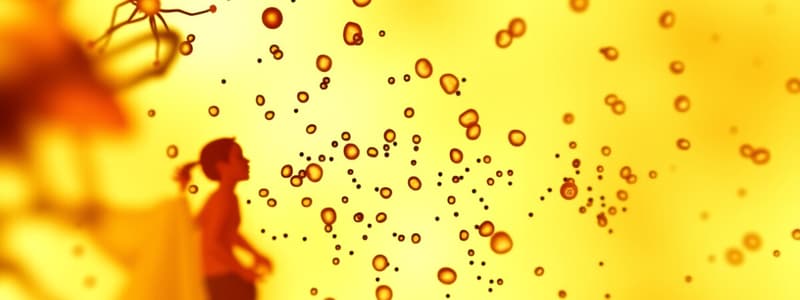Podcast
Questions and Answers
What is microevolution?
What is microevolution?
Evolution on its smallest scale: the change in allele frequencies in a population over the generations.
What are the three main mechanisms that cause changes in allele frequencies?
What are the three main mechanisms that cause changes in allele frequencies?
Natural selection, genetic drift, gene flow.
What is the only mechanism that is adaptive, improving the match between organisms and their environment?
What is the only mechanism that is adaptive, improving the match between organisms and their environment?
Natural selection.
Define genetic drift:
Define genetic drift:
Define gene flow:
Define gene flow:
What are discrete characters?
What are discrete characters?
What are quantitative characters?
What are quantitative characters?
What are two ways of measuring genetic variation in a population, using molecular biology?
What are two ways of measuring genetic variation in a population, using molecular biology?
What's a cline, what produces it, and why does it suggest natural selection?
What's a cline, what produces it, and why does it suggest natural selection?
What is frequency-dependent selection?
What is frequency-dependent selection?
What is neutral variation?
What is neutral variation?
Gene variability (average heterozygosity) tends to be greater than _________ because...
Gene variability (average heterozygosity) tends to be greater than _________ because...
When phenotypic effects are neutral, the variation between the populations appears to have resulted from _______
When phenotypic effects are neutral, the variation between the populations appears to have resulted from _______
Clines probably result from?
Clines probably result from?
What are the four key points of genetic drift?
What are the four key points of genetic drift?
What is translocation, and how could it be beneficial?
What is translocation, and how could it be beneficial?
How does gene duplication occur and how might it play a role in evolution?
How does gene duplication occur and how might it play a role in evolution?
What are three mechanisms by which sexual reproduction shuffles existing alleles?
What are three mechanisms by which sexual reproduction shuffles existing alleles?
What is a population?
What is a population?
What is a gene pool?
What is a gene pool?
Define fixed alleles:
Define fixed alleles:
What does the Hardy-Weinberg principle state?
What does the Hardy-Weinberg principle state?
What are the five principles of Hardy-Weinberg equilibrium?
What are the five principles of Hardy-Weinberg equilibrium?
Equations for Hardy-Weinberg equilibrium and what do the parts mean?
Equations for Hardy-Weinberg equilibrium and what do the parts mean?
Red flowers (R) are dominant to white flowers (r). In a population of 500, 25% show rr phenotype. How many homozygous dominant and how many heterozygous?
Red flowers (R) are dominant to white flowers (r). In a population of 500, 25% show rr phenotype. How many homozygous dominant and how many heterozygous?
64% phenotype of dominant color (red) and 36% rr (white). What is the frequency of the dominant allele?
64% phenotype of dominant color (red) and 36% rr (white). What is the frequency of the dominant allele?
What factor results in random, nonadaptive change in allelic frequencies?
What factor results in random, nonadaptive change in allelic frequencies?
How might an allele that's slightly disadvantageous increase in frequency?
How might an allele that's slightly disadvantageous increase in frequency?
Explain what happens in the founder effect, an example of genetic drift:
Explain what happens in the founder effect, an example of genetic drift:
Explain what happens in the bottleneck effect, an example of genetic drift:
Explain what happens in the bottleneck effect, an example of genetic drift:
Define relative fitness:
Define relative fitness:
What is the relative fitness of a sterile mule?
What is the relative fitness of a sterile mule?
What is directional selection?
What is directional selection?
What is disruptive selection?
What is disruptive selection?
What is stabilizing selection?
What is stabilizing selection?
What is often the result of sexual selection?
What is often the result of sexual selection?
What is intrasexual selection?
What is intrasexual selection?
What is intersexual selection?
What is intersexual selection?
Explain two ways in which genetic variation is preserved in a population.
Explain two ways in which genetic variation is preserved in a population.
What's heterozygote advantage?
What's heterozygote advantage?
Give four reasons why natural selection can't produce perfect organisms:
Give four reasons why natural selection can't produce perfect organisms:
A fruit fly population has a gene with two alleles, A1 and A2. What proportion of the flies carry both A1 and A2?
A fruit fly population has a gene with two alleles, A1 and A2. What proportion of the flies carry both A1 and A2?
There are 40 individuals in population 1, all of which have genotype A1A1, and there are 25 individuals in population 2, all of genotype A2A2. What is the observed genetic variation likely an example of?
There are 40 individuals in population 1, all of which have genotype A1A1, and there are 25 individuals in population 2, all of genotype A2A2. What is the observed genetic variation likely an example of?
The chief cause of genetic variation among human individuals is?
The chief cause of genetic variation among human individuals is?
Study Notes
Microevolution and Mechanisms
- Microevolution refers to minor changes in allele frequencies within a population across generations.
- Major mechanisms influencing allele frequency changes include natural selection, genetic drift, and gene flow.
- Natural selection is the only mechanism that is adaptive, enhancing the fit between organisms and their environment.
Genetic Drift and Gene Flow
- Genetic drift involves chance events that can drastically change allele frequencies, especially in small populations.
- Example: In a small flower population, the infertility of one allele could lead to its loss.
- Gene flow is the movement of fertile individuals or their gametes between populations, which diminishes genetic differences.
Genetic Variation
- Discrete characters show only two trait options (e.g., flower color in pea plants).
- Quantitative characters exhibit a continuous range (e.g., human skin color).
- Genetic variation can be quantified at both the gene level (average heterozygosity) and molecular level (nucleotide variability).
Cline and Natural Selection
- A cline is a gradient of genetic variation among populations across a geographic range, influenced by environmental factors.
- Example: Temperature affects allele frequency in mummichog fish, indicating natural selection at work.
Types of Selection
- Frequency-dependent selection indicates that a phenotype's fitness declines as it becomes common.
- Neutral variation consists of nucleotide differences that do not impact an organism's function, often resulting from genetic drift.
- The Hardy-Weinberg principle describes the equilibrium of allele and genotype frequencies in a population without external influences.
Hardy-Weinberg Equilibrium Principles
- Key principles include: no mutations, random mating, no natural selection, large population size to minimize genetic drift, and no gene flow to maintain allele frequencies.
Effects of Genetic Drift
- Small populations are more susceptible to random changes in allele frequencies.
- Genetic drift can reduce genetic variation, impacting a population's adaptability and potentially leading to harmful alleles becoming fixed or lost.
Mechanisms of Sexual Reproduction
- Sexual reproduction introduces genetic variation through crossing over, independent assortment of chromosomes, and random fertilization.
Definitions and Concepts
- A population consists of individuals of the same species residing in the same area and capable of interbreeding.
- A gene pool encompasses all alleles across all loci in a population.
- Fixed alleles occur when only one allele for a trait exists, leading to homogeneity.
Fitness and Selection Types
- Relative fitness refers to an individual's contribution to the gene pool of the next generation compared to others.
- Directional selection favors one extreme phenotype, while disruptive selection favors extremes at both ends, and stabilizing selection favors intermediate traits.
Sexual Selection Dynamics
- Intrasexual selection involves competition among one sex (usually males) for mates, whereas intersexual selection involves mate choice, often based on appearance or behavior.
Preservation of Genetic Variation
- Diploidy protects recessive alleles in heterozygotes, preserving genetic variation that may be beneficial under changing conditions.
- Balancing selection occurs when multiple forms are maintained, including heterozygote advantage, where heterozygotes have greater fitness.
Limits of Natural Selection
- Natural selection cannot create perfect organisms due to constraints like reliance on existing variations, historical limitations of species, adaptations as compromises, and the influence of chance events.
Genetic Variation in Populations
- Genetic variation arises primarily through the reshuffling of alleles during sexual reproduction and is often affected by genetic drift in isolated populations.
- For specific genetic distributions in populations, allele frequencies can be predicted using Hardy-Weinberg equilibrium equations.
Studying That Suits You
Use AI to generate personalized quizzes and flashcards to suit your learning preferences.
Description
Test your knowledge of the evolution of populations with flashcards covering microevolution concepts and mechanisms. This quiz includes definitions and key terms essential for understanding how allele frequencies change over generations. Perfect for studying genetics and evolutionary biology.




